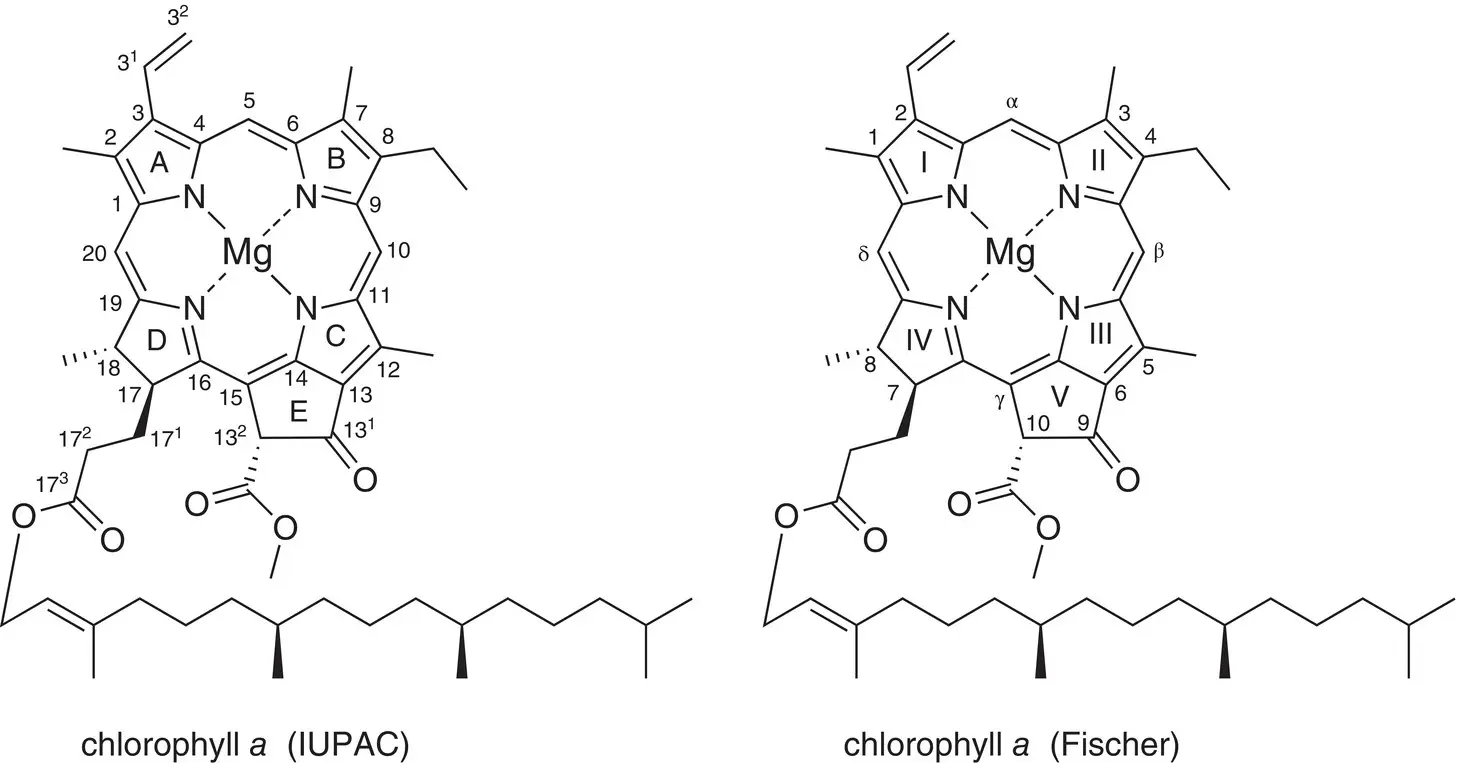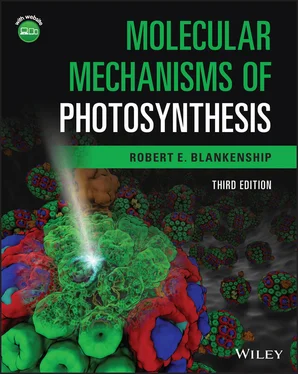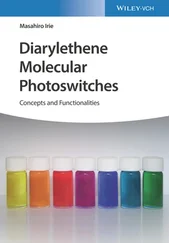1 Arnon, D. I. (1984) The discovery of photosynthetic phosphorylation. Trends in Biochemical Sciences 9: 1–5.
2 Arnon, D. I., Allen, M. B., and Whatley, F. R. (1954) Photosynthesis by isolated chloroplasts. Nature 174: 394–396.
3 Benson, A.A. (2002) Following the path of carbon in photosynthesis: A personal story. Photosynthesis Research 73: 29–49.
4 Calvin, M. (1989) 40 years of photosynthesis and related activities. Photosynthesis Research 21: 3–16.
5 Creager, A. N. H. (2013) Life Atomic: Radioisotopes in Science and Medicine. Chicago: University of Chicago Press.
6 Duysens, L. M. N. (1989) The discovery of the 2 photosynthetic systems – a personal account. Photosynthesis Research 21: 61–79.
7 Duysens, L. M. N., Amesz, J., and Kamp, B. M. (1961) Two photochemical systems in photosynthesis. Nature 190: 510–511.
8 Emerson, R. and Arnold, W. (1932a) A separation of the reactions in photosynthesis by means of intermittent light. Journal of General Physiology 15: 391–420.
9 Emerson, R. and Arnold, W. (1932b) The photochemical reaction in photosynthesis. Journal of General Physiology 16:191–205.
10 Emerson, R., Chalmers, R., and Cederstrand, C. (1957) Some factors influencing the longwave limit of photosynthesis. Proceedings of the National Academy of Sciences USA 43: 133–143.
11 Gaffron, H. and Wohl, K. (1936) Zur theorie der assimilation. Naturwissenschaften 24: 81–90; 103–107.
12 Gest, H. and Kamen, M. D. (1948) Studies on the phosphorus metabolism of green algae and purple bacteria in relation to photosynthesis. Journal of Biological Chemistry 176: 299–318.
13 Govindjee, S. D. and Björn, L. O. (2017) Evolution of the Z‐scheme of photosynthesis: A perspective. Photosynthesis Research 133: 5–15.
14 Govindjee, S. D., Beatty, J. T., Gest, H., and Allen, J. F., (eds.) (2005) Discoveries in Photosynthesis. Dordrecht: Springer.
15 Hill, R. (1939) Oxygen produced by isolated chloroplasts. Proceedings of the Royal Society of London. Series B 127: 192–210.
16 Hill, J. F. (2012) Early pioneers of photosynthesis research. In: J. J. Eaton‐Rye, B. C. Tripathy, and T. D. Sharkey, (eds.) Photosynthesis. Dordrecht: Springer.
17 Hill, R. and Bendall, F. (1960) Function of the two cytochrome components in chloroplasts: A working hypothesis. Nature 186: 136–137.
18 Jaffe, B. (1976) Crucibles: The Story of Chemistry, 4th Edn. New York: Dover.
19 Magiels, G. (2010) From Sunlight to Insight: Jan Ingen‐Housz, the Discovery of Photosynthesis & Science in the Light of Ecology. Brussels: Academic & Scientific Publishers.
20 Mitchell, P. (1979) Keilin's respiratory chain concept and its chemiosmotic consequences. Science 206: 1148–1159.
21 Myers, J. (1994) The 1932 experiments. Photosynthesis Research 40: 303–310.
22 Myers, J. and French, C. S. (1960) Relationships between time course, chromatic transient, and enhancement phenomena of photosynthesis. Plant Physiology 35: 963–969.
23 Nickelsen, K. (2015) Explaining Photosynthesis: Models of Biochemical Mechanisms, 1840–1960. Dordrecht: Springer.
24 Nickelsen, K. and Govindjee, S. D. (2011) The Maximum Quantum Yield Controversy: Otto Warburg and the “Midwest‐Gang”. Bern: Bern Studies in the History and Philosophy of Science.
25 van Niel, C. B. (1941) The bacterial photosyntheses and their importance for the general problem of photosynthesis. Advances in Enzymology 1: 263–328.
26 Rabinowitch, E. I. (1945) Photosynthesis and Related Processes, Vol. 1. New York: Interscience Publishers.
27 Walker, D. A. (1992) Energy, Plants and Man, 2nd Edn. Brighton: Oxygraphics.
Chapter 4 Photosynthetic pigments: structure and spectroscopy
The lifeblood of a photosynthetic organism is its pigments. Without them, light cannot be absorbed, and therefore energy cannot be stored. There are a remarkable number of pigments found in different photosynthetic organisms, and they serve a variety of functional roles. In this chapter, we will learn about the different types of pigments, with an emphasis on how the chemical and spectroscopic properties of the pigments are determined by their structures and the functions that they perform in the photosynthetic process. The chlorophylls are named a – f , and the bacteriochlorophylls a – g , in order of their discovery. In addition, we will consider carotenoids and bilins, the two other major classes of photosynthetic pigments.
Chlorophylls have long been investigated (Scheer, 1991; Grimm et al ., 2006). The word chlorophyll was first used by Pelletier and Caventou in 1818 to describe the green pigments that are involved in photosynthesis in higher plants. Three Nobel prizes have been given at least in part for studies on the structural determination of chlorophyll. Richard Wilstätter was honored in 1915 for his work that established the major features of the chlorophyll structure, including the empirical formula and the presence of magnesium (Mg). Hans Fischer was awarded the 1930 Nobel prize in part because he determined the complete structure, and Robert Woodward received the 1965 prize in part for his work that culminated in the total synthesis of chlorophyll.
4.1 Chemical structures and distribution of chlorophylls and bacteriochlorophylls
The empirical chemical formula for chlorophyll a is C 55H 72N 4O 5Mg. This simple representation is entirely inadequate to convey the essential properties of this extraordinary molecule. The structural formula for chlorophyll a is shown in Fig. 4.1. It is a squarish planar molecule, about 10 Å on a side. A space‐filling model of chlorophyll a is shown in Fig. 4.2. The Mg atom in the center of the planar portion is coordinated to four nitrogen atoms. The nitrogens are each part of a substructural element of the molecule that is derived from pyrrole, a cyclic organic compound with a nitrogen atom in a five‐membered ring with four carbons. For this reason, chlorophylls and related compounds are often referred to as tetrapyrroles. A fifth ring is formed in the lower right corner, and a long hydrocarbon tail is attached to the lower left (in the standard representation). Chemically, the chlorophylls are related to the porphyrins, which are also tetrapyrroles, but the porphyrins are generally more symmetric molecules.

Figure 4.1 Numbering schemes for chlorophylls and bacteriochlorophylls. Chlorophyll a is shown, although the same basic numbering scheme applies to all chlorophyll‐type pigments. Left: the current IUPAC standard system. Right: the older Fischer numbering system. Hydrogen atoms are not shown.

Figure 4.2 Space filling model of chlorophyll a . Carbon is shown as black, hydrogen as white, oxygen as red, nitrogen as blue, and magnesium as orange.
The five rings in chlorophylls are lettered A through E, and the substituent positions on the macrocycle are numbered clockwise, beginning in ring A, as shown in Fig. 4.1, according to the officially recognized International Union of Pure and Applied Chemistry (IUPAC) nomenclature. An older nomenclature known as the Fischer system is also shown in Fig. 4.1. All of the older literature uses the Fischer nomenclature, so it is necessary to be conversant with both systems. In this book, the IUPAC system will be used exclusively.
Читать дальше














